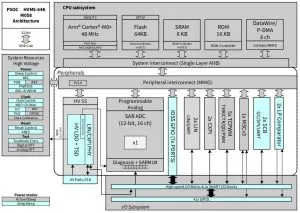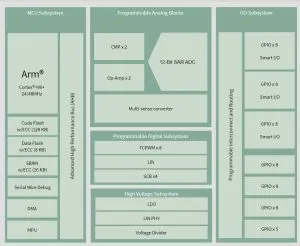The PSOC 4 HVMS family is built around a 24 or 48MHz Arm Cortex-M0+ processor, with up to 128kbyte of flash and 8kbyte of ram.
The ICs also have what Infineon calls ‘high-voltage’ capability for almost-direct connection to 12 and 24V vehicle batteries as they include an LDO that can accept power at between 4.5 and 28V for connection to 12 and 24V batteries, and is tolerant to 42V abs max. Total device dissipation must not exceed 1W.
External protection is required between the battery terminal and MCU LDO in the form of a transient suppressor diode, a series reverse-polarity protection diode, a series 4.7Ω resistor and capacitors. Multiple internal voltage rails are generated, all of which need their own external capacitors. ICs come with either a 3.3V LDO or a 5V LDO.
On the subject of variants, not all devices in the family, actually called CY8C1xxxxxHVSxy, have capacitive sensing: y=1 or 3 for those that have.

When capacitive sensing is included, is can be though any of up to 41 GPIO pins, and is implemented in on instance of the company’s fifth generation ‘multi-sense converter’.
The converter can autonomous scan multiple capacitive channels without CPU intervention, and the data sheet refers to a sensing range of ~2 to 50pF with 500 or 50count/1pF sensitvity. Drive modes, strengths and slew rates are programmable.
“Touch buttons, sliders, touch pads, hands-on detection in steering wheels, door handles for vehicle access, passenger detection, window lifters, seat adjustment and sunroof control” are among potential application, said the company.
On-board functional safety hardware has been included aimed at ISO 26262 ASIL B as a Safety Element out of Context.
This includes a memory protection unit, window watchdog timer (with challenge-response), over-voltage and brown-out monitoring on the LDO output and 1.8V rails, and error detection and correction on the safety-critical flash and ram.
“In the automotive market, functional safety is increasingly being applied to low-end microcontroller applications,” said Infineon. “The demand for visually appealing interiors is also driving the demand for robust capacitive sensing solutions that work under challenging conditions.”
Among other peripherals are a LIN 2.2A (ISO 17987) interface, optional 20kbit/s CXPI channels, a 12bit SAR ADC, operational amplifiers and comparators.
Packages are all wettable flank QFNs, either 6 x 6mm 32pad, 7 x 7mm 48pad, 8 x 8mm 56pad or 9 x 9mm 64pad.
Support software includes a peripheral driver library aimed at ISO26262 safety requirements and a capacitive sensing library.
The family web page is here, and its data sheet here or here for 128kbyte flash version
At Embedded World this year, Infineon revealed a touch-on-metal sensing technique using similar ICs

